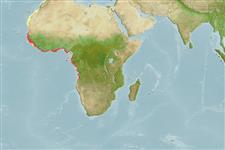>
Eupercaria/misc (Various families in series Eupercaria) >
Haemulidae (Grunts) > Haemulinae
Etymology: Brachydeuterus: Greek, brachys, eia = short + Greek, deuter = two (Ref. 45335).
More on author: Valenciennes.
Environment: milieu / climate zone / depth range / distribution range
Ecologia
marinhas; estuarina bentopelágico; intervalo de profundidade 10 - 100 m (Ref. 57395), usually 15 - 80 m (Ref. 26999). Tropical; 35°N - 16°S, 19°W - 14°E (Ref. 54289)
Eastern Atlantic: west coast of Africa, from Mauritania to Angola (Ref. 57395). Also reported from Morocco (Ref. 2135).
Comprimento de primeira maturação / Tamanho / Peso / Idade
Maturity: Lm 14.8 range ? - ? cm
Max length : 30.0 cm TL macho/indeterminado; (Ref. 57395); common length : 23.0 cm TL macho/indeterminado; (Ref. 3660); idade máx. registrada: 7 anos (Ref. 1113)
Espinhos dorsais (total): 10 - 13; Raios dorsais (total): 11-14; Espinhos anais 3; Raios anais : 9 - 10. Diagnosis: body oblong and compressed; dorsal profile slightly and regularly convex; snout shorter than eye diameter (Ref. 57395). Mouth large, oblique (Ref. 5377, 57395) and protrusible (Ref. 57395). Lower jaw slightly prominent; 2 anterior pores on chin, followed by a median pit bearing openings of two large pores (Ref. 57395). Eyes large (Ref. 5377). Dorsal fin deeply notched; caudal fin deeply forked; scales ctenoid on body and head (Ref. 57395).
Coloration: back olivaceous, sides silvery to white; dark spot at angle of opercle; sometimes several small, dark spots on dorsal-fin base (Ref. 57395). Fins grey (Ref. 5377).
Inhabits coastal waters (Ref. 2683). Semipelagic, remains near the bottom during the day and moves up to the open water at night (Ref. 5377, 57395). Occasionally enters lagoons and estuaries at start of sexual maturation (Ref. 57395). Occurs over sandy and muddy bottoms. Feeds on invertebrates and small fishes (Ref. 5535).
Ciclo de vida ou comportamento de acasalamento
Maturidade | Reprodução | Desova | Ovos | Fecundidade | Larvas
Distinct pairing during breeding (Ref. 205).
Roux, C., 1990. Haemulidae. p. 783-788. In J.C. Quero, J.C. Hureau, C. Karrer, A. Post and L. Saldanha (eds.) Check-list of the fishes of the eastern tropical Atlantic (CLOFETA). JNICT, Lisbon; SEI, Paris; and UNESCO, Paris. Vol. 2. (Ref. 6946)
Status na Lista Vermelha da UICN (Ref. 130435)
Warning: mysqli::__construct(): (HY000/1040): Too many connections in /var/www/html/includes/func_getlabel.php on line 46
Can't connect to MySQL database (fbapp). Errorcode: Too many connections
